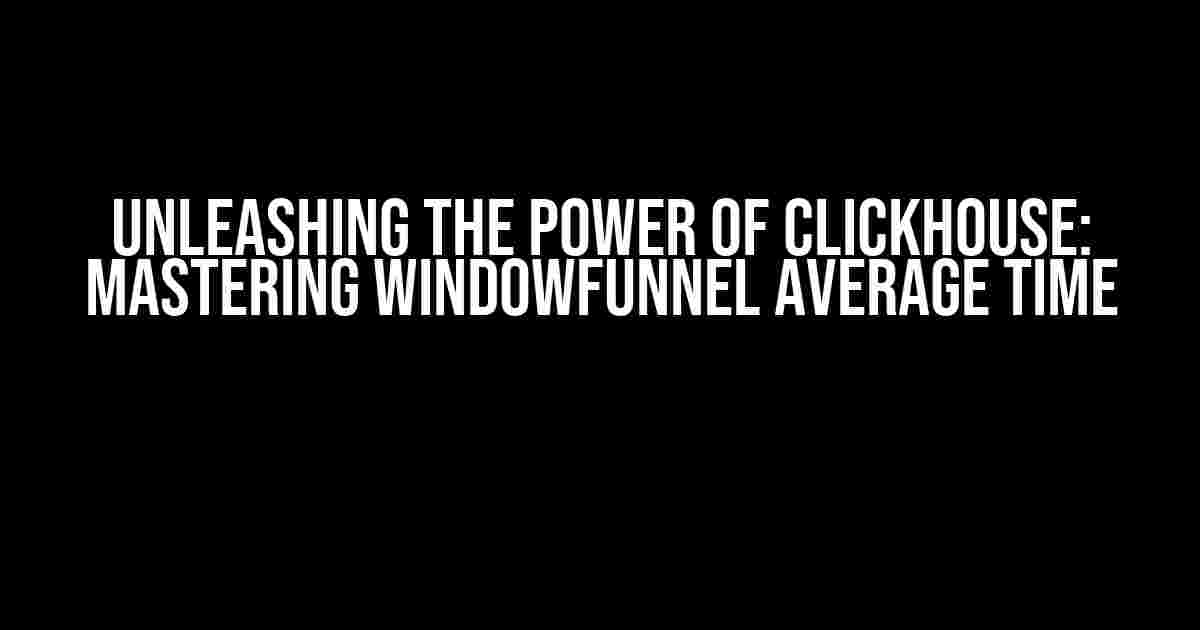Are you tired of drowning in a sea of data, struggling to extract meaningful insights from your ClickHouse database? Look no further! In this article, we’ll dive into the world of WindowFunnel Average Time, a powerful tool that will revolutionize the way you analyze and visualize your data.
What is WindowFunnel Average Time?
Before we dive into the nitty-gritty, let’s define what WindowFunnel Average Time is. In ClickHouse, WindowFunnel Average Time is a window function that calculates the average time it takes for a user to complete a specific sequence of events, such as a funnel. This function is a game-changer for businesses that rely on funnel analytics to optimize their customer journeys.
The Anatomy of a Funnel
A funnel is a series of events that a user must complete to achieve a desired outcome. Think of it like a sales pipeline, where users progress from one stage to the next, eventually reaching the final conversion goal. A typical funnel might look like this:
- Users land on a website (event 1)
- Users fill out a form (event 2)
- Users complete a purchase (event 3)
The goal is to optimize the funnel to increase the number of users who complete the final conversion goal. But how do you measure the average time it takes for users to move through the funnel? That’s where WindowFunnel Average Time comes in.
Calculating WindowFunnel Average Time
The syntax for WindowFunnel Average Time is as follows:
SELECT
avg(time) OVER (PARTITION BY user_id ORDER BY timestamp) AS avg_time
FROM
events
WHERE
event_name IN ('event1', 'event2', 'event3')
AND timestamp BETWEEN '2022-01-01' AND '2022-01-31';
In this example, we’re calculating the average time it takes for users to complete the funnel, which consists of events 1, 2, and 3. The `PARTITION BY` clause groups the results by user ID, and the `ORDER BY` clause sorts the events by timestamp. The `WHERE` clause filters the events to only include those within the specified date range.
Understanding the Results
The result of the query will be a table with a single column, `avg_time`, which represents the average time it takes for users to complete the funnel. But what does this number actually mean?
Let’s say the result is 3.5 hours. This means that, on average, it takes users 3 hours and 30 minutes to complete the funnel. This information is invaluable for optimizing the customer journey, as it highlights areas where users may be getting stuck or dropping off.
Common Use Cases for WindowFunnel Average Time
Now that we’ve covered the basics, let’s explore some common use cases for WindowFunnel Average Time:
- Optimizing checkout processes: By calculating the average time it takes for users to complete a checkout process, you can identify bottlenecks and optimize the user experience.
- Improving onboarding flows: WindowFunnel Average Time can help you identify areas where users are struggling to complete onboarding tasks, allowing you to simplify the process and improve conversion rates.
- Enhancing customer support: By analyzing the average time it takes for users to resolve issues, you can optimize your support processes to reduce resolution times and improve customer satisfaction.
Best Practices for Implementing WindowFunnel Average Time
When implementing WindowFunnel Average Time, keep the following best practices in mind:
- Define clear event sequences: Ensure that your event sequences are well-defined and accurately reflect the customer journey.
- Use relevant timestamp columns: Use timestamp columns that accurately reflect the time at which events occur.
- Optimize your queries: Optimize your queries to ensure they are efficient and scalable.
Conclusion
In conclusion, WindowFunnel Average Time is a powerful tool that can help you unlock insights into your customers’ behavior and optimize their journey. By mastering this function, you’ll be able to:
- Identify bottlenecks in your funnel
- Improve conversion rates
- Enhance customer satisfaction
So, what are you waiting for? Start unleashing the power of ClickHouse WindowFunnel Average Time today and take your analytics to the next level!
| Event | Average Time |
|---|---|
| Event 1 | 10 minutes |
| Event 2 | 30 minutes |
| Event 3 | 1 hour |
Example table showing average times for each event in the funnel.
Frequently Asked Question
Get ready to dive into the world of ClickHouse and uncover the secrets of WindowFunnel Average Time!
What is WindowFunnel Average Time in ClickHouse?
WindowFunnel Average Time is a powerful analytical function in ClickHouse that allows you to calculate the average time spent by users within a specific funnel. It’s like having a superpower to analyze user behavior and optimize your sales funnel!
How do I implement WindowFunnel Average Time in my ClickHouse query?
To implement WindowFunnel Average Time, you’ll need to use the `windowFunnel` function in your ClickHouse query. The syntax is `windowFunnel(averageTime, ‘session_id’, ‘event_time’, [‘step1’, ‘step2’, …])`. Replace ‘session_id’ with your unique identifier, ‘event_time’ with the timestamp column, and [‘step1’, ‘step2’, …] with the steps you want to track in your funnel.
Can I use WindowFunnel Average Time to analyze user behavior across multiple events?
Absolutely! WindowFunnel Average Time is designed to handle multiple events and steps in your funnel. You can track user behavior across multiple events, such as clicks, scrolls, and conversions, to gain a deeper understanding of their journey.
How does WindowFunnel Average Time handle missing events in my funnel?
WindowFunnel Average Time ignores missing events in your funnel, so you don’t need to worry about gaps in your data. It will only consider the events that are present in your data, giving you an accurate picture of user behavior.
What are some common use cases for WindowFunnel Average Time in ClickHouse?
Some common use cases for WindowFunnel Average Time include analyzing user behavior in e-commerce funnels, tracking customer journeys in SaaS applications, and optimizing conversion rates in marketing campaigns. The possibilities are endless!
